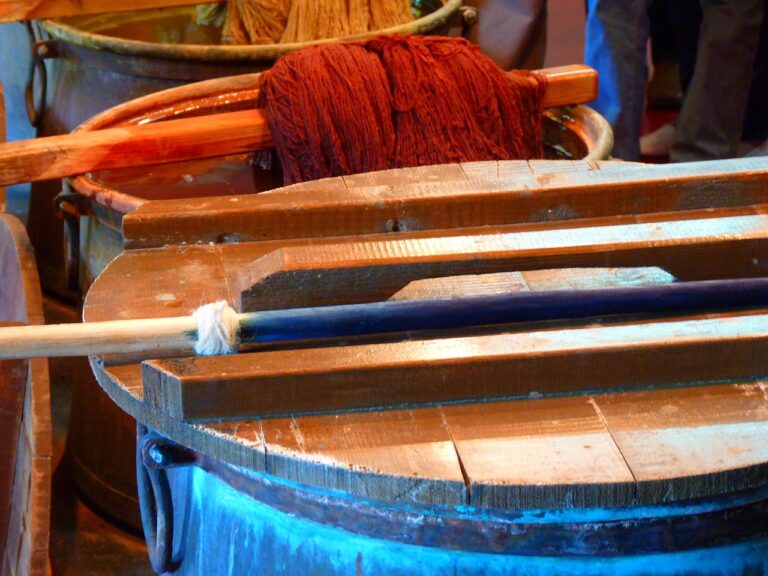How to hand dye textiles
Hand-dyeing textiles is a creative process that allows you to customize fabrics with your own unique designs. Here are the main points to consider:
Materials Needed:
- Fabric or Textile (natural fibres like cotton, silk, or wool work best)
- Fabric Dye (the type of dye you need will depend on the fabric you’re using)
- Dye Fixative or Salt (to set the dye)
- Large Pot or Bucket (for dyeing)
- Rubber Gloves
- Stirring Stick
- Plastic Cover (for protecting your work area)
Steps:
- Choose Your Fabric: Natural fibres like cotton, silk, or wool tend to take dye better than synthetic fibres. The fabric should be clean and free of any finishes.
- Prepare Your Dye Bath: Follow the instructions on your fabric dye to prepare your dye bath. This usually involves dissolving the dye in hot water in your pot or bucket. You may also need to add salt or a dye fixative to help the dye bond to the fabric.
- Wet Your Fabric: Before adding your fabric to the dye bath, it’s a good idea to wet it thoroughly. This helps the dye distribute evenly.
- Dye Your Fabric: Add your wet fabric to the dye bath. Stir it around to make sure it’s fully submerged and the dye is evenly distributed.
- Wait: The amount of time you need to leave your fabric in the dye bath will depend on the type of dye you’re using and how dark you want the colour to be. This could be anywhere from a few minutes to a few hours.
- Rinse and Dry: Once your fabric has reached the desired colour, remove it from the dye bath and rinse it under cold water until the water runs clear. Then, hang your fabric up to dry.
- Wash: After your fabric is dry, you should wash it (either by hand or in a washing machine on a gentle cycle) to remove any excess dye.
Hand-dyeing textiles is a fascinating and creative process that allows you to transform plain fabric into a unique piece of art. Whether you’re looking to refresh old clothes or create custom designs, this guide will walk you through the basics of hand-dyeing textiles.

Photo by Matt Seymour on Unsplash
Materials Needed
Before you begin, gather your materials. You’ll need fabric or textiles, preferably made from natural fibres like cotton, silk, or wool, as they absorb dye better than synthetic materials. Next, you’ll need fabric dye. The type of dye you choose will depend on the fabric you’re using, so make sure to check the compatibility. A dye fixative or salt is also necessary to set the dye and ensure its longevity.
For the dyeing process, a large pot or bucket is essential. Remember, dyeing can be a messy process, so use something you don’t mind staining. Additionally, you’ll need rubber gloves to protect your hands, a stirring stick for mixing, and a plastic cover to protect your work area.
The Dyeing Process
Start by choosing your fabric. Ensure it’s clean and free of any finishes to allow the dye to penetrate effectively.
Next, prepare your dye bath. Follow the instructions on your fabric dye to do this. Typically, this involves dissolving the dye in hot water in your pot or bucket. At this stage, you may also need to add salt or a dye fixative, which helps the dye bond to the fabric.
Before adding your fabric to the dye bath, wet it thoroughly. This step is crucial as it helps the dye distribute evenly across the fabric, preventing blotches.
Now, it’s time to dye your fabric. Add your wet fabric to the dye bath, ensuring it’s fully submerged. Stir it around for even distribution of the dye.
The waiting game begins now. The duration you leave your fabric in the dye bath depends on the type of dye you’re using and the depth of colour you desire. This could range from a few minutes to a few hours.
Once your fabric has achieved the desired colour, remove it from the dye bath. Rinse it under cold water until the water runs clear. This step removes any excess dye. Following this, hang your fabric up to dry.
After your fabric is dry, wash it to remove any remaining dye. You can do this either by hand or in a washing machine on a gentle cycle.
Conclusion
Hand-dyeing textiles may seem daunting at first, but with a little practice, you can create beautiful, custom fabrics. Remember, the process can be a bit messy, so protect your work area and wear clothes you don’t mind staining. Always follow the safety instructions on your fabric dye. The results can be unpredictable, but that’s part of the fun of hand-dyeing! Embrace the process and enjoy the unique, one-of-a-kind pieces you create.

